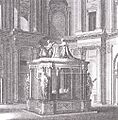Germain Pilon facts for kids

Germain Pilon (born around 1525, died 1590) was a famous French sculptor. He lived during the exciting time of the French Renaissance. Pilon created many beautiful sculptures. He was especially known for his work on tombs.
About Germain Pilon
Germain Pilon was born in Paris, France. He learned how to sculpt from his father, Andre Pilon. They even worked together on some projects. One of his early works might be the marble sculpture Diana with a Stag. This piece is now at the Louvre museum.
Pilon became very skilled with different materials. He worked with marble, bronze, wood, and terra cotta. He also made models for goldsmiths in Paris. His art showed a lot of realism and emotion. It was influenced by the School of Fontainebleau and the great artist Michelangelo.
Much of Pilon's work was for important tombs. He worked on the Valois Chapel at the Saint Denis Basilica. This chapel was designed by Francesco Primaticcio. Pilon was a favorite artist of Queen Catherine de' Medici.
Famous Sculptures
Pilon created many important sculptures. Here are some of his most famous works:
- Tomb of Francis I (1558): Pilon made eight smaller statues for this tomb. He worked with Philibert de l'Orme on this project.
- Monument for the Heart of Henry II (1561–1562): This monument is at the Louvre. Pilon sculpted the beautiful Three Graces from one piece of marble. The king's heart was placed in a bronze urn held by the Graces. The original urn was destroyed, but a copy was made.
- Tomb of Henry II and Catherine de' Medici (1561–1573): This large tomb is at the Abbey Church of Saint Denis Basilica. Pilon made the kneeling bronze figures of the king and queen. These show them alive and praying. He also sculpted the realistic figures of the king and queen in death. These are found at the center of the monument. Pilon also created four Virtues statues for the corners.
- Figures of Henry II and Catherine de' Medici in Coronation Robes (1583): These later figures are also at the Abbey Church of Saint Denis Basilica.
- Resurrection of Christ (reunited in 1933): This work includes figures of Christ and the tomb guardians. It is now at the Musée du Louvre.
- Virgin of Pity (around 1585): This sculpture is made of terra cotta. It can be seen at the Louvre.
- Tomb of Valentine Balbiani (1574): This tomb is also at the Louvre.
- Descent from the Cross (1580–1585): This is a bronze relief sculpture. It is displayed at the Louvre.
- Three Fates: This sculpture is located at the Hôtel de Cluny in Paris.
Images for kids
-
Resurrection of Christ, Louvre
-
Tomb of Henry II and Catherine de' Medici, Saint-Denis Basilica, with marble effigies
See also
 In Spanish: Germain Pilon para niños
In Spanish: Germain Pilon para niños
- Catherine de' Medici's building projects
- French art







